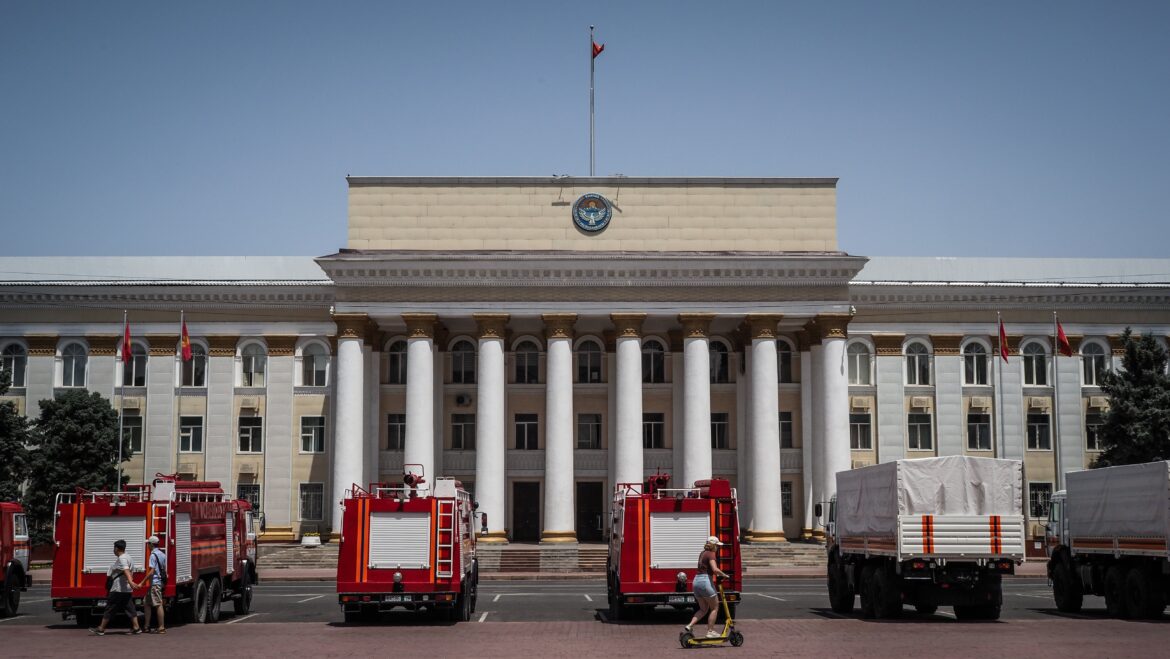Bishkek is the capital and largest city of Kyrgyzstan, situated in the north of the country near the border with Kazakhstan. It lies in the fertile Chüy Valley at the foot of the Tian Shan mountains, giving it both strategic and agricultural importance. It’s the political, economic, and cultural heart of Kyrgyzstan, but its past has seen many transformations.
Short history of Bishkek
The area around Bishkek has been inhabited for centuries thanks to its rich pastures and trade routes. During the Silk Road era, settlements thrived in the Chüy Valley, serving as rest stops for merchants and caravans. However, Bishkek itself began as a modest fortress in the 19th century.
In 1825, the Kokand Khanate built a fort on the site to control local trade and nomadic tribes. The Russians captured it in 1862, demolished the fort, and established a garrison town called Pishpek. This marked the beginning of a new phase, as Slavic settlers arrived, and the settlement gradually grew into an administrative hub.

When the Bolsheviks took over Central Asia, Pishpek became part of the newly created Kyrgyz Autonomous Soviet Socialist Republic in 1926. At that time, it was renamed Frunze, in honour of Mikhail Frunze, a Red Army leader born in the city. Under Soviet rule, it transformed from a dusty frontier town into a planned city with wide boulevards, Soviet-style architecture, factories, and universities.
With Kyrgyzstan’s independence in 1991, the city adopted the name Bishkek, which is linked to a traditional wooden churn used to make kumis (fermented mare’s milk), a staple of Kyrgyz nomadic culture. Since then, it has developed into a vibrant capital balancing Soviet heritage, Central Asian traditions, and modern influences.
How to get to Bishkek?
By Air
Manas International Airport (FRU) is Bishkek’s main gateway, located about 30 km northwest of the city. It has direct flights from major regional hubs like Istanbul, Moscow, Dubai, Tashkent, and Almaty.
From the airport, travellers usually take a taxi, ride-hailing app, or shared minibus (marshrutka) into the city centre.
By Road
Bishkek is connected by long-distance buses and shared minibuses (marshrutkas) to nearby cities in Kazakhstan and within Kyrgyzstan.
The Almaty–Bishkek route is especially popular, with frequent services that cross the border at Korday.
Roads from Osh, Karakol, and Issyk-Kul also converge in Bishkek, making it a transport hub inside Kyrgyzstan.
By Car
Driving into Bishkek is common for regional travellers. Border crossings with Kazakhstan are well-used, but travellers should be prepared for possible delays.
Renting a car is an option inside Kyrgyzstan, especially for those planning to explore the mountains and countryside beyond the capital. I can wholeheartedly recommend the company “Rent a Car 4×4 in Kyrgyzstan Bishkek”, which can be contacted on WhatsApp: +996508811770. Super friendly and unproblematic experience.



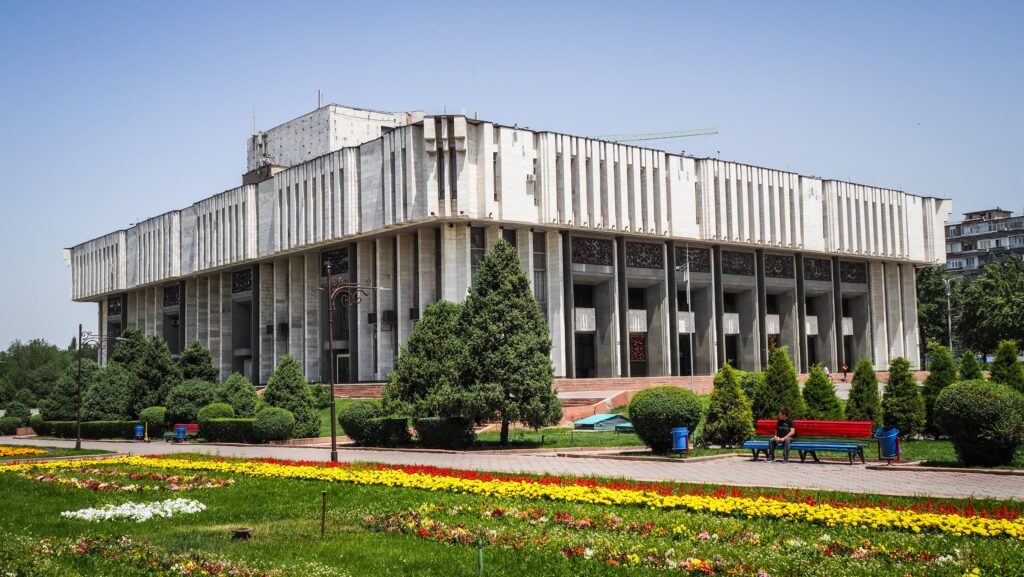
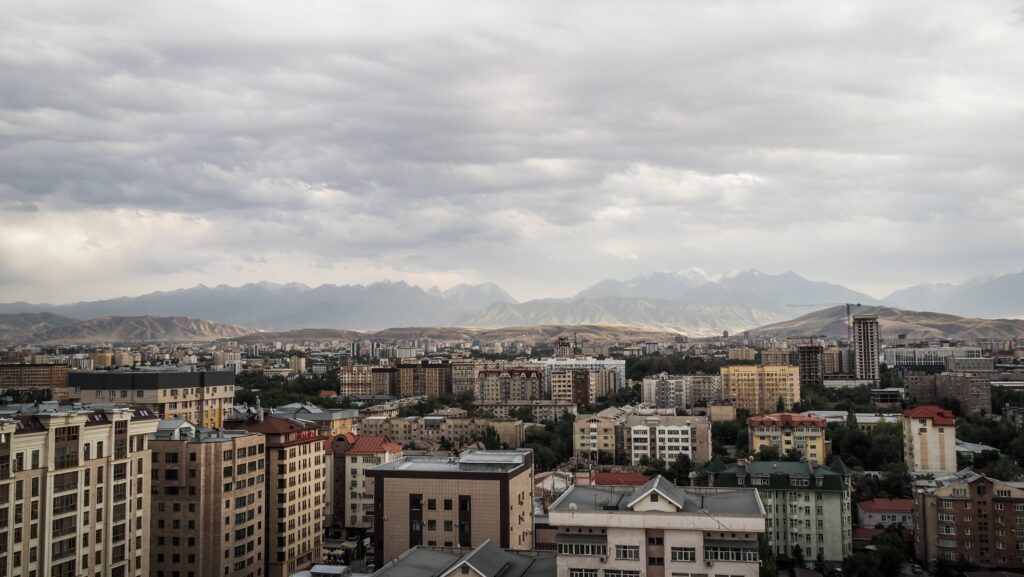
The best time to visit
Spring (April–June): This is one of the most pleasant periods. The weather warms up, the mountains around the city are still capped with snow, and the valleys are covered in wildflowers. It’s a great time for city walks and light hiking.
Summer (July–August): Summers are hot, often above 30°C, but the city’s tree-lined streets offer shade. This is the season when many people use Bishkek as a base to head into the cooler mountains, lakes, and alpine pastures nearby.
Autumn (September–October): Another ideal window to visit. The heat has eased, the skies are usually clear, and harvest season fills local markets with fresh produce. The golden foliage also makes the city and the surrounding valleys especially scenic.
Winter (November–March): Bishkek experiences cold, snowy winters. While the city itself may feel grey, this is the time for skiing and winter sports in resorts like Chunkurchak or Karakol, which are accessible from Bishkek.
Where to stay in Bishkek?
During my several-day stay in Bishkek, I stayed in five different hotels:
Inter Hotel Bishkek: Probably the best price-to-quality ratio. Good locations, modern room.
Hotel Touristan: The room was huge and clean. The receptionist was super helpful, and I even received a fridge magnet as a gift. The only negative was that the AC didn’t work too well.
Malinka: More like a guesthouse rather than a hotel. The room was well equipped with a kettle, tea, sugar, and toiletries. Very friendly owner who let me leave a part of my luggage for several days as I was hiking in Ala Archa National Park.
Hotel T: Very simple, however, a comfortable room.
Terrasse Hotel & Bar: A luxurious establishment offering stunning panoramic views of the mountains and the city. I had to get a really good deal on booking.com as in the next days the rooms became 4 times more expensive.
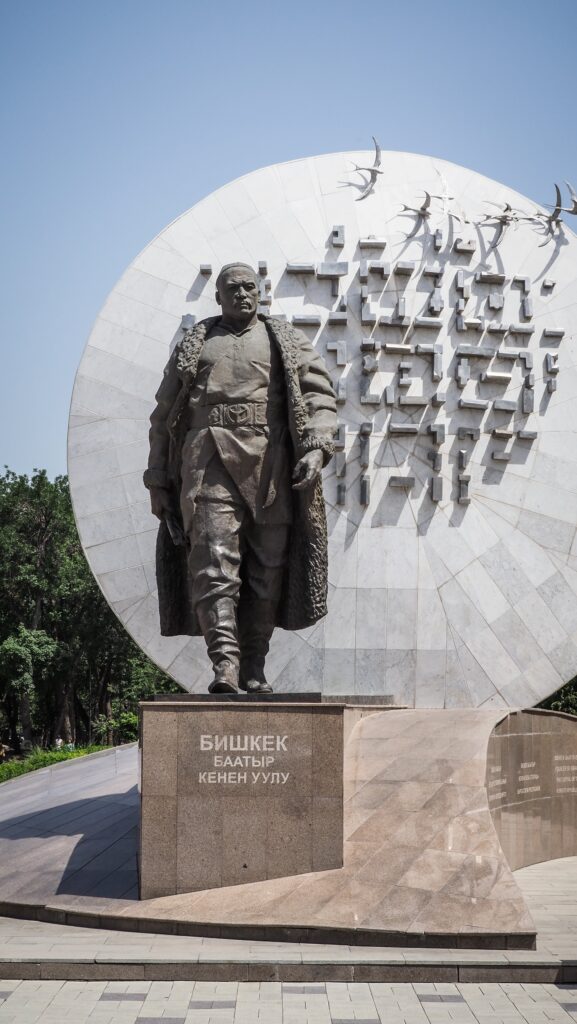


What to see in Bishkek?
Ala-Too Square
This is Bishkek’s central square and the main gathering point for public life. It’s where parades, festivals, and national celebrations take place. The square is framed by government buildings, fountains, and monuments, making it a symbolic heart of the capital. In the evenings, it becomes lively with locals strolling and families enjoying the open space.
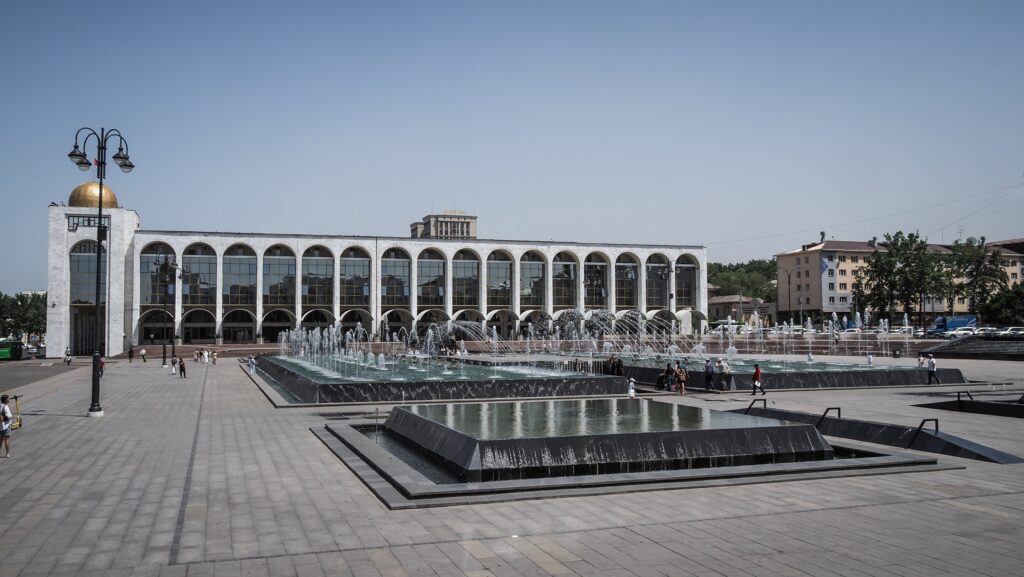
Paramount Kyrgyz Republic Flag
This is one of the tallest flagpoles in the country, standing prominently in central Bishkek near Ala-Too Square. The massive flag of Kyrgyzstan waves high above the city, making it both a patriotic symbol and a striking landmark. Visitors often stop here for photos because of the scale of the flag and its importance as a national emblem.
Next to the flag stands a large monument dedicated to Manas, the legendary epic hero of Kyrgyz folklore. Manas represents bravery, unity, and leadership, and his story has been passed down for centuries in oral tradition. The statue shows him in a commanding pose on horseback.


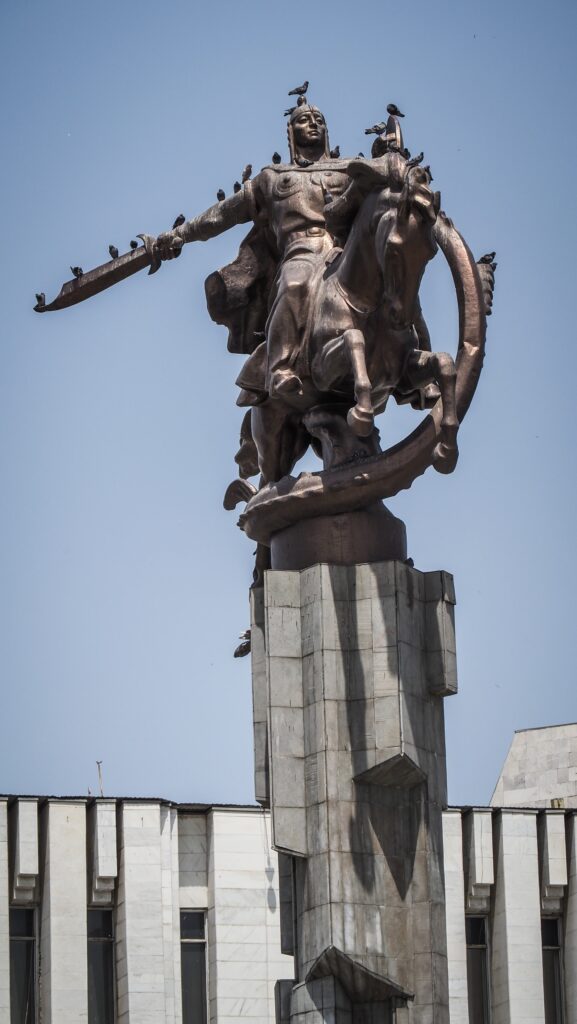
State History Museum
Right on Ala-Too Square, this museum provides insight into Kyrgyzstan’s long past, from ancient nomadic cultures to the Soviet era and beyond. Its exhibits cover archaeology, ethnography, and political history, giving visitors a broad sense of how the nation has developed through the centuries.
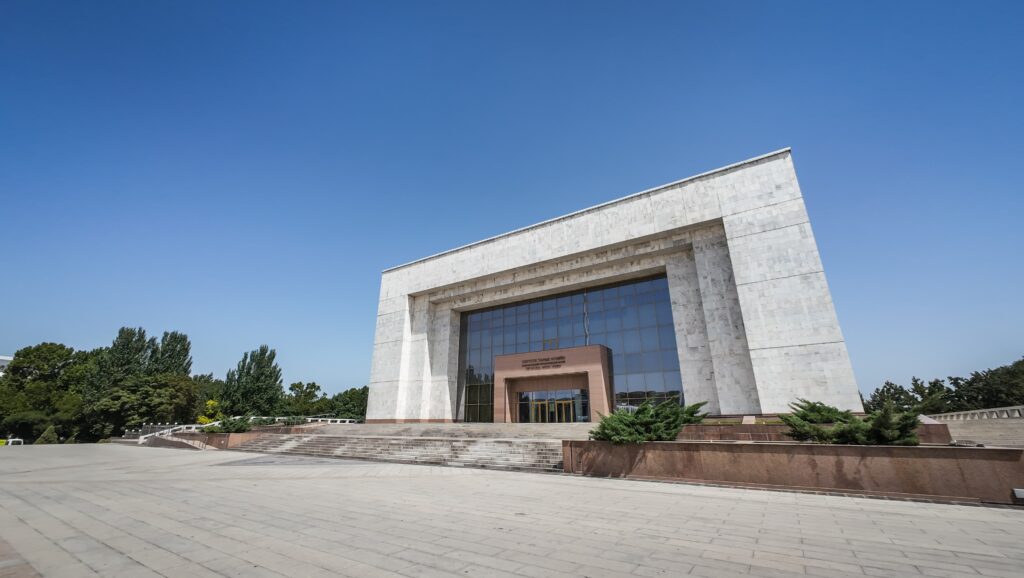
Vladimir Lenin Statue
Although many Soviet monuments have been removed across the region, Bishkek still preserves a large statue of Lenin. Once placed prominently in Ala-Too Square, it has since been moved behind the State History Museum.
Panfilov Park
This leafy park is one of the city’s favourite green spaces. It features tree-lined paths, amusement rides, and a relaxed atmosphere. Families, couples, and students gather here, especially in warmer months, to enjoy a casual day outdoors.
Kurmanzhan Datka Statue
Kurmanzhan Datka (1811–1907) is remembered as one of Kyrgyzstan’s most influential historical leaders. Born in the mountainous Alay Valley, she rose to prominence in a time when women rarely held authority. After the death of her husband, she assumed leadership and earned the respected title of “Datka,” which was used for high-ranking commanders and governors in the Kokand Khanate.
She became known not only for her ability to lead but also for her skills as a negotiator. During the 19th century, when the Russian Empire was expanding into Central Asia, she managed to maintain a degree of stability for her people by pursuing diplomacy instead of open resistance, which would likely have brought destruction.
Kurmanzhan Datka was admired for her sense of justice and her concern for the welfare of her community. Because of her strength and wisdom, she earned the nickname “Queen of the South.”
Oak Park
One of Bishkek’s oldest parks, known for its shaded avenues and outdoor art installations. Sculptures, fountains, and benches make it a pleasant place to stroll. The park also hosts cultural events and provides a refreshing green escape right in the city centre.
Gapar Aitiev National Museum of Fine Arts
This museum houses a wide range of visual art, from traditional Kyrgyz felt works and crafts to paintings and modern art pieces. Named after Kyrgyzstan’s first professional artist, it offers a window into both local creativity and the influence of broader art movements.
M. V. Frunze Museum
Dedicated to Mikhail Frunze, a Bolshevik leader born in Bishkek (then Pishpek), this museum showcases his personal belongings, documents, and the role he played in Soviet history. The building itself is notable because it was constructed around the house where Frunze grew up, preserving it inside.
Old Central Mosque
This is one of the city’s oldest Islamic landmarks, dating back to the late 19th century. It’s smaller than the new mosque but carries a lot of historic weight. For many years it served as the main place of worship before the grand new mosque was built. People still gather here, especially older generations who have a connection to it.
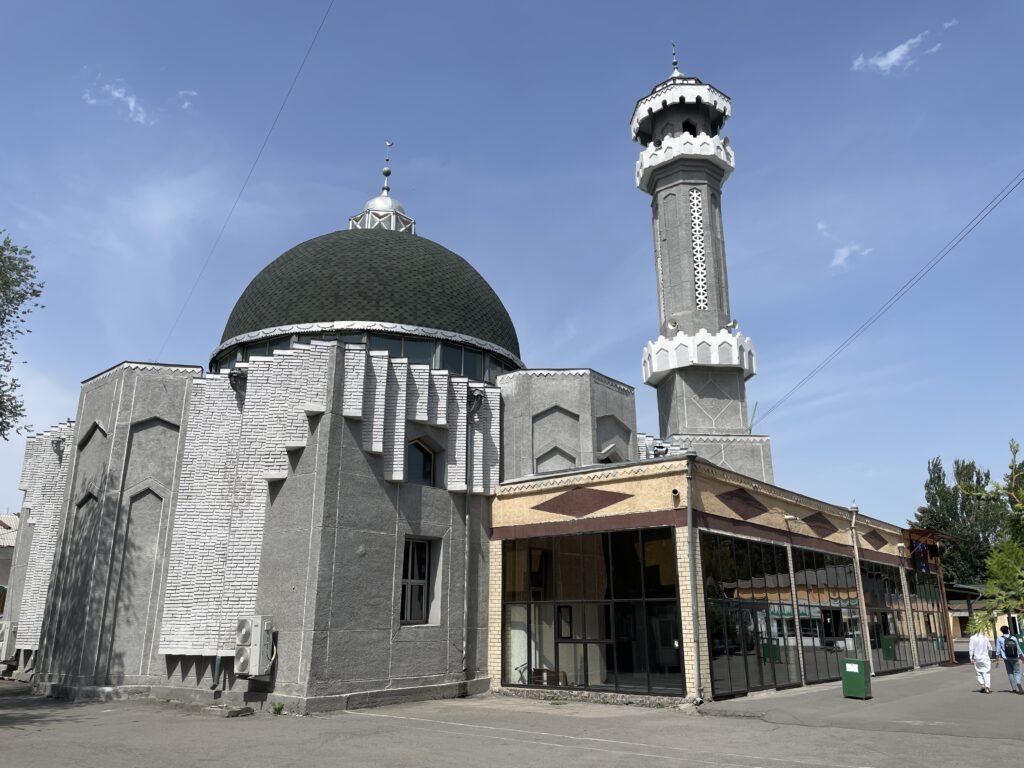
Victory Square
Located right in the city center, this square honors the Soviet victory in World War II. At its heart is a striking monument shaped like a yurt frame, symbolizing both Kyrgyz heritage and the mothers who waited for their sons to return from war. Eternal flames burn here, and it’s a place where ceremonies and quiet moments of remembrance often take place.
Fighters of the Revolution Monument
This monument is dedicated to those who took part in the 1917 revolution and the turbulent years that followed. It’s a heavy Soviet-style memorial, meant to show strength and sacrifice.
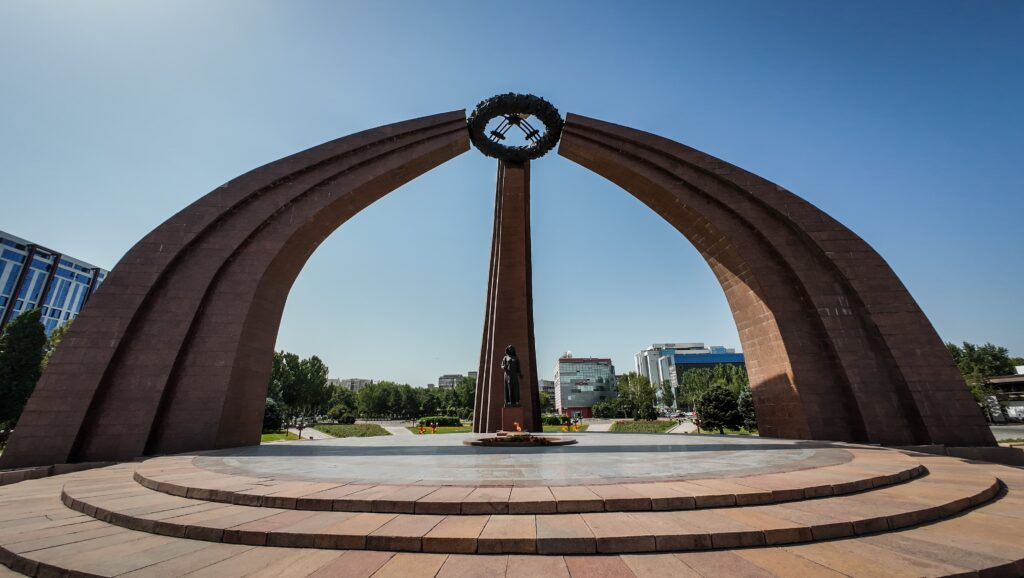
Bishkek Central Mosque
Opened in 2018, this is now the largest mosque in Central Asia. A gift from Turkey, it was built in a grand Ottoman style, white marble, elegant domes, tall minarets. It can hold tens of thousands of worshippers. During Friday prayers and big holidays, the courtyard overflows with people.
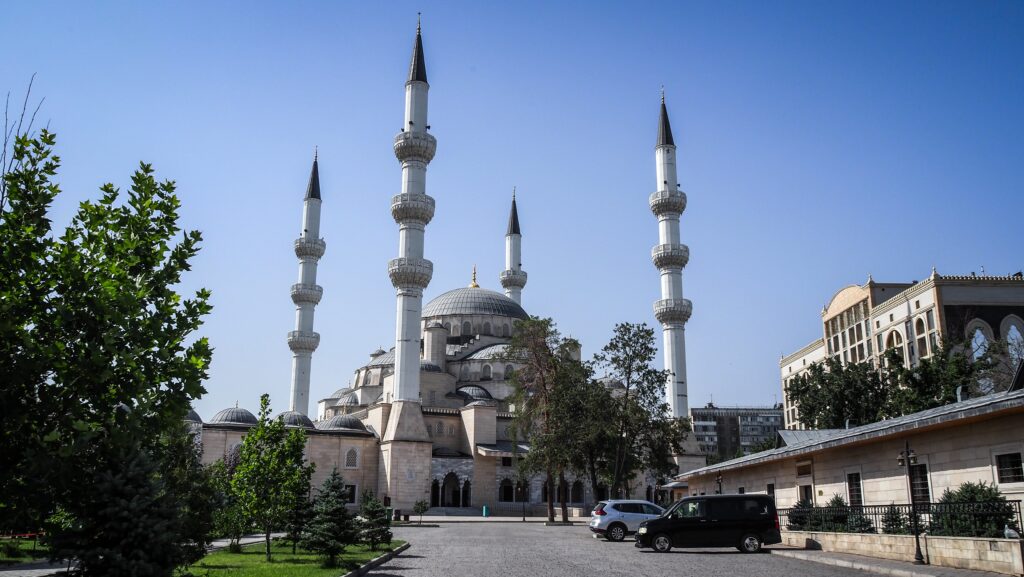

Kyrgyz State Circus
Housed in a round, space-age style building from the 1970s, the circus is pure Soviet architecture. It’s still operating, with performances ranging from traditional acrobatics to animal acts. Even if you don’t go inside, the quirky building itself is a reminder of how Soviet planners loved futuristic designs.
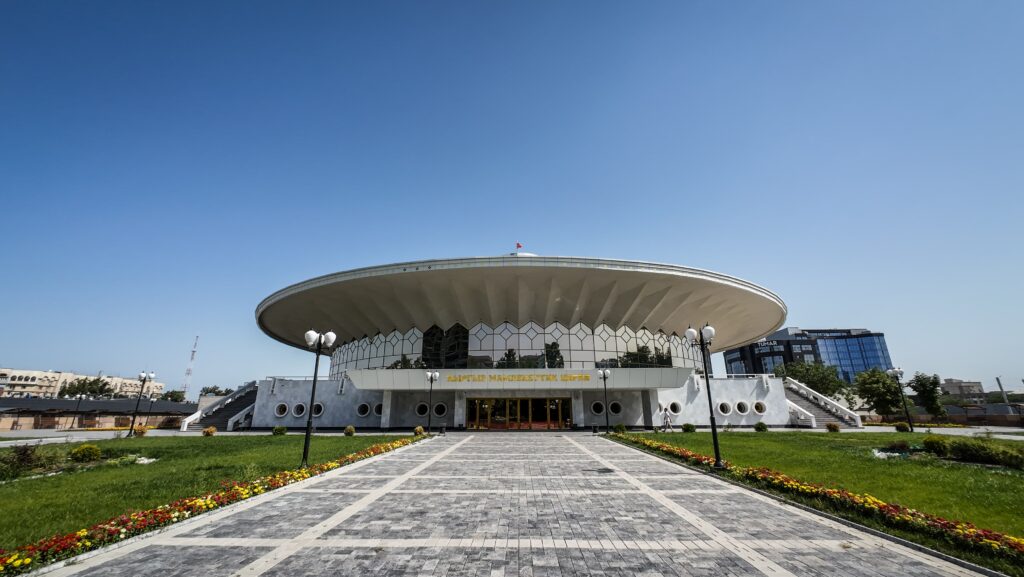
The White House
No relation to Washington’s White House, this one is a government building in Bishkek. A huge block of white marble, very Soviet in appearance, it once served as the headquarters of the Communist Party. Today it’s home to the presidential administration. The area around it has been the stage for protests and revolutions in Kyrgyzstan’s recent history.

Holy Resurrection Cathedral
A traditional Russian Orthodox cathedral with blue domes and golden crosses, built in the early 20th century. It survived the Soviet period when many churches were closed or destroyed. Today it’s an active church, especially busy on Orthodox holidays.
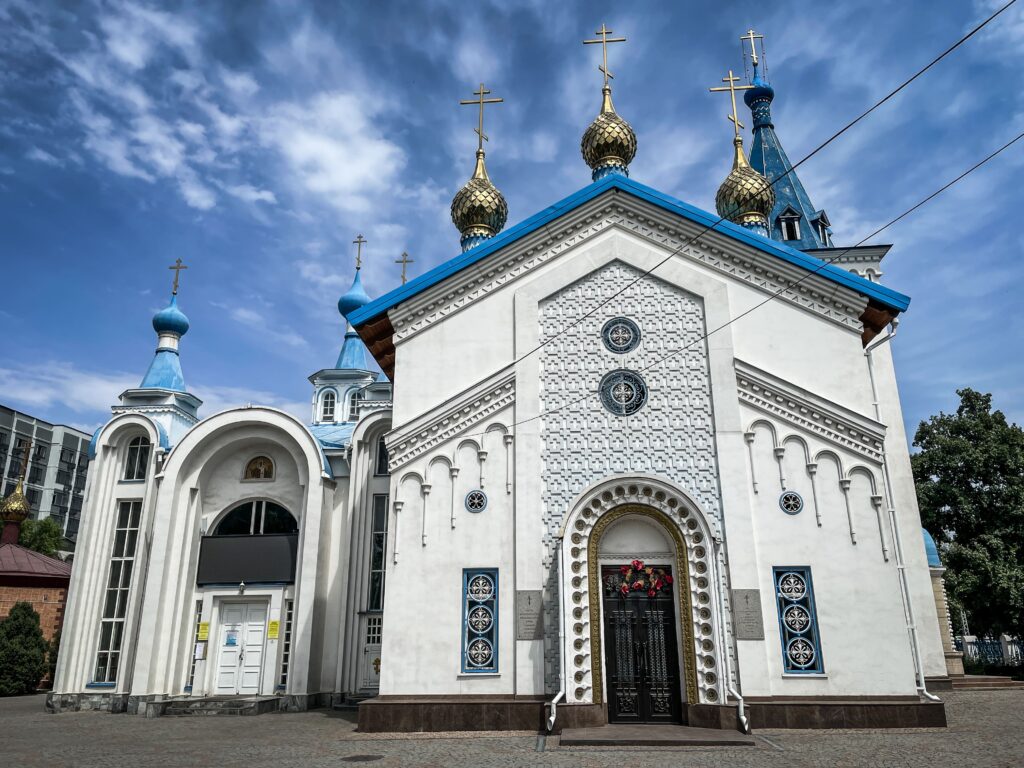
Manas Statue
Manas is the legendary hero of Kyrgyz epic poetry and the symbol of national pride. His statue stands tall near Philharmonia Square, with Manas on horseback, sword raised. It’s a popular meeting spot and one of the key symbols of Bishkek.
Bishkek Railway Station
Built in the 1940s, the station is modest but elegant, with Soviet-era design elements. The clock tower is a local landmark, and the station still has an old-world atmosphere, even though air travel has overtaken rail in popularity.
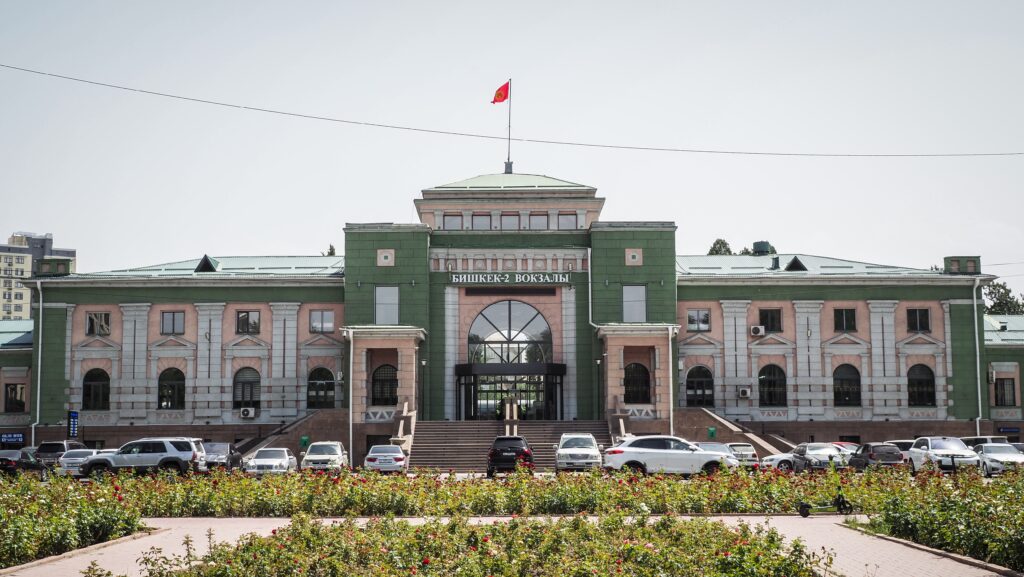
Osh Bazaar
One of the liveliest places in Bishkek. Here you’ll find everything from fresh produce and spices to traditional hats (kalpaks), household items, and clothes. It’s noisy, crowded, and full of character. For visitors, it’s the best spot to experience the everyday hustle of Kyrgyz life, bargain with vendors, and taste local street food like samsa and fresh bread. Be careful as the place is infamous for pickpockets!
What to see outside of Bishkek?
Ata Beyit Memorial
Located a short drive south of Bishkek, this site is both a cemetery and a memorial complex. It honours victims of Stalinist purges in the 1930s, many of whom were buried in mass graves here. Later, the cemetery was expanded to include graves of cultural and political figures, including the famous writer Chingiz Aitmatov. The place is solemn and reflective, set against a backdrop of mountains, making it significant for understanding Kyrgyzstan’s 20th-century history.
The guide in the museum was very nice and he played the movie for me, very often stopping it and giving English commentary.
Flag of Kyrgyzstan at Boz-Boltok Mountain
On Boz-Boltok Mountain, visitors can find an enormous flag of Kyrgyzstan flying proudly. The site offers sweeping views over Bishkek and the surrounding valley. It has become a popular spot for both locals and tourists. The climb or drive up adds a touch of adventure to the visit.
Chon Aryk Mountain
Chon Aryk is located near Bishkek and is more of a natural escape than a tourist hotspot. It’s a great place for hiking, offering fresh air, open fields, and mountain scenery that isn’t far from the city.
Alamedin Valley
Alamedin Gorge is located in the Kyrgyz Ala-Too range, which is part of the northern Tian Shan Mountains. The gorge stretches along the Alamedin River and is known for its steep, rocky slopes, alpine meadows, and pine forests.
The area is popular for hiking, horseback riding, and camping. Trails lead to waterfalls and higher mountain passes that connect to other valleys. Because of its relatively close location to Bishkek (about 30 kilometres away), it’s one of the more accessible natural escapes for locals and visitors.
Read more in a separate post HERE.
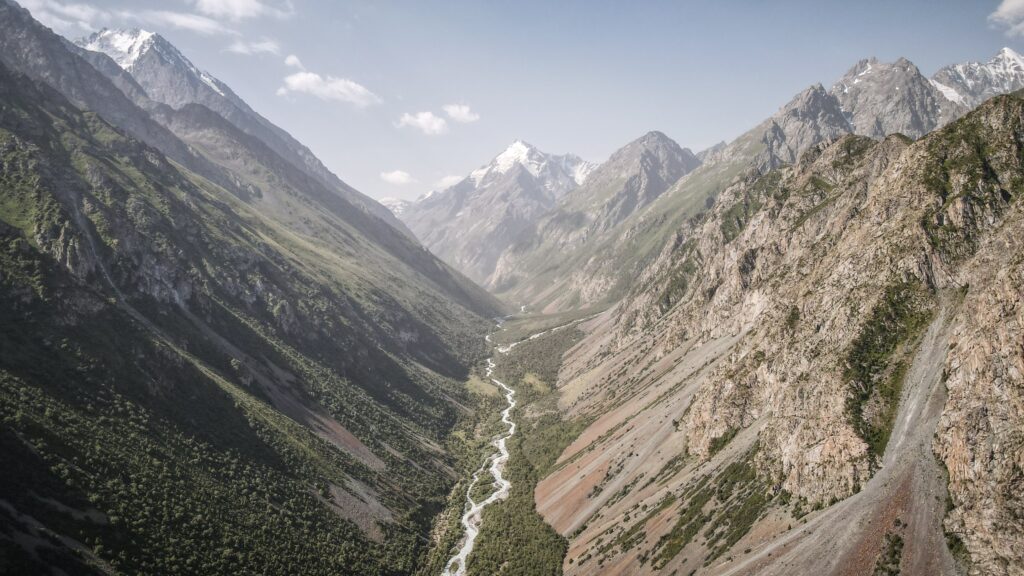
Sky Bridge & Chunkurchak Valley
The Sky Bridge is located in the Chunkurchak Gorge, about 35 km from the centre of Bishkek. It was built in 2021 and has quickly become a popular attraction for both locals and visitors. The bridge spans approximately 125 meters and is suspended at an elevation of roughly 2,400 meters above sea level. What makes it especially striking is the drop beneath it, around 700 meters down into the gorge, giving anyone who crosses an intense mix of breathtaking views and adrenaline.
Read more in a separate post HERE.
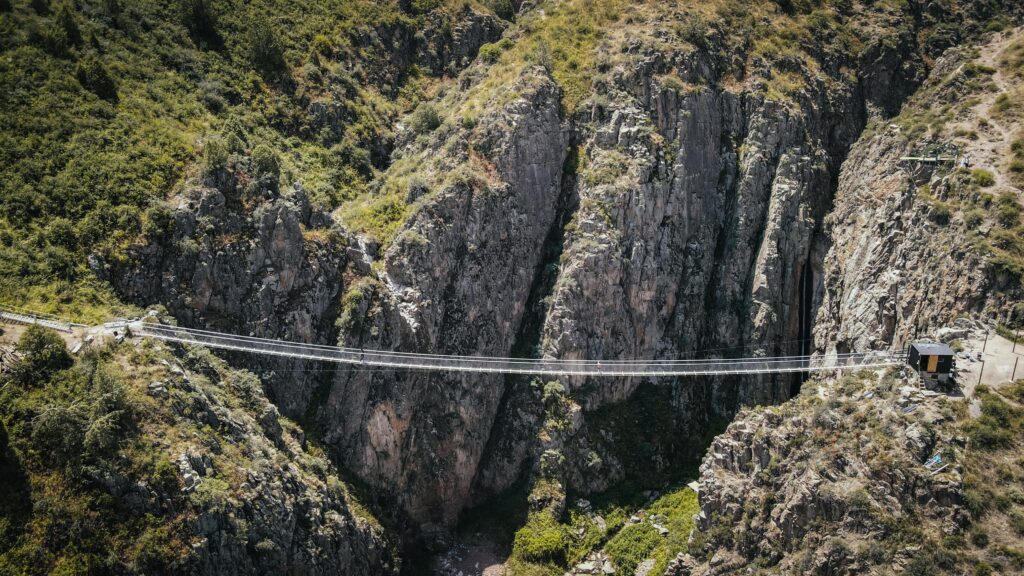
Ala Archa National Park
This park is one of the most famous natural attractions near Bishkek, just about 40 km away. Nestled in the Tian Shan mountains, it’s a haven for outdoor lovers. Visitors come for day or multiday hikes, picnics, and to admire glaciers, waterfalls, and alpine landscapes. Because it’s so close to the city, it’s a favourite weekend getaway for Bishkek residents looking for fresh air and dramatic scenery. Luckily, the majority of them don’t go any further than the end of the asphalt road, so you can be sure to find peace by going a bit further into the park.
Read more about hiking in the park in the separate post HERE.

